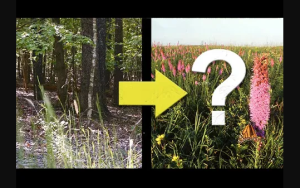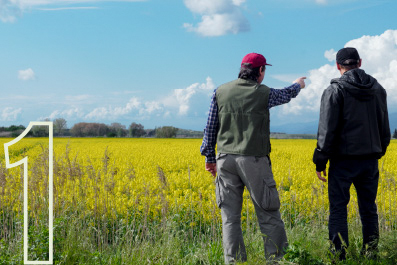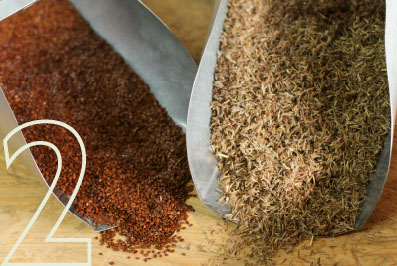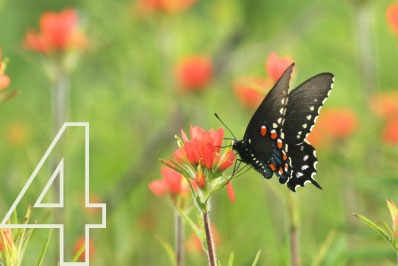Landscaping with Wildflower Meadows
Wildflowers for formal and
informal landscaping
Flowerbed vs. wildflower meadow
A flowerbed has a more formal look that is very pleasing to the eye, making it an appropriate choice for, say, a front yard. Using native plants to achieve this formal look is not only beautiful but also a great chance to increase biodiversity, provide for pollinators, manage storm water, and create a more sustainable landscape.
To achieve this look, certain design elements such as borders, focal points, and large masses of a few plants are often used. You can best achieve exactl plant positioning and spacing with potted plants. Also, potted plants give instant results, which is advantageous in a highly visible area. Note: If you choose to use potted plants, purchase them from a local provider who understands plant genetics.
Wildflower meadows, on the other hand, are a great choice in larger spaces where the cost and labor to plant potted plants becomes prohibitive or where the work of mulching is not desired. The plants touch and the weed control is achieved by the close plants of the plants, which shades the soil, rather than mulch.
Seeds are the most effective way to establish a wildflower meadow. The wait for a wildflower meadow is longer, often taking three years before many of the wildflowers bloom, but the results are worth the wait. Also, the inclusion of annual or biennial species that bloom the first year or two can help add some color while other seeds establish.
Seeds and potted plants can also be used together. Establish a formal flowerbed on the most highly visible side of a wildflower meadow. Or, plant a few potted plants in strategic locations in a wildflower meadow so that there are some flowers that bloom sooner.
Check out our Resources to learn about formal landscaping and source native potted plants.
Learn nature’s landscaping secrets
The native prairies, glades, savannas, and wetlands have many secrets that every landscaper should learn. And, since a wildflower meadow is basically a re-creation of one of these ecosystems, let’s learn their secrets:
1. Choose plants based upon soil.
There is a sweet spot for each plant as far as soil moisture, from wet to dry. Obviously, a water lily and a cactus grow in very different sites and neither would do well if their sites were swapped.
Characteristics such as rocky soil, clay soil (e.g. after topsoil has been removed), ridgetop or side slope landscape positions, and rooting restrictions (e.g. bedrock or fragipan) all lend dry characteristics.
Wet soils are often evident because they are the places that your shoes sink into the soil at time other than just after a rain. These locations are often where water comes to the surface from within the soil.
Mesic soils (those that are not too wet nor too dry) are deep with good organic matter content and few rocks. Keep in mind that if the slope of the land is facing west or south, the site will be drier than the same site that faces north or east due to sun intensity.
It’s possible to alter a site to make it match the requirements of the desired plants. Remove topsoil to make a site drier. This has the added benefit of removing weed seeds. Add organic matter (e.g. compost) to make it moister. But remember that growing plants where they are not adapted will either create a high maintenance landscape or the plants will not thrive.
2. Choose a diversity of wildflowers.
Since native wildflowers do not bloom season long, the secret to continuous color is a diversity of wildflowers. This also provides season-long pollen and nectar sources for butterflies, hummingbirds, honeybees, and other pollinators.
3. Choose plants based upon sun and shade.
Just as different plants prefer different soil moisture, each plant has a certain amount of sun or shade in which it thrives. The amount of shade is a range with full sun on one end, full shade on the other, and varying amounts of sun and shade in between. Understand the site to be planted. Is it evenly sunny or shady, or is the shade only in certain areas? What percent of the day does a given area get direct sunlight?
4. Include grass and grass-like plants.
Native ecosystems contain a component of native grasses and grass-like plants. A mix of both warm and cool season grasses is part of nature’s design and is beneficial for a wildflower meadow.
The grasses help shade the ground between wildflower plants, which discourages weeds. Visually, they provide beautiful hues of rusty red, various browns, bright orange, and silver in the late fall and winter. Additionally, the grasses offer support to tall blooming wildflowers and carry a fire if a controlled burn is desired to renew the earth for next year’s flowers. At least 25% of a meadow planting should be grasses.
5. Seed in winter.
By design, many seeds—especially wildflowers but also some grasses—will not germinate until they have been through winter. This is a protective mechanism to ensure that the seed does not germinate in fall when the temperatures and soil moisture are favorable only to find the plant is too small to live through the winter. So, built into the seed is the knowledge that after winter comes spring, and spring is the time to start growing. Therefore, plant wildflowers in winter or cold-moist stratify the seed.
6. Don’t fertilize.
Natural ecosystems don’t have a fertilizer buggy to bring nitrogen, phosphate, or potash, and most wildflower meadows don’t have any need of it either. Nitrogen is especially problematic as it encourages weed growth and can make the wildflowers tall and gangly, and cause them to fall over.
Consider using fertilizer if: the pH is really low or really high; the phosphate or potash levels are really low (common on areas where the topsoil is missing—read our New Dirt Work guidelines); you need a carrier to spread the seed. Even in these cases, do not apply nitrogen.
7. Remove the old growth.
In natural, pre-settlement ecosystems, fire was present. The frequency varied between ecosystem type, but almost every one of them experienced fire in the dormant season. The fires removed the last summer’s dead plant leaves to allow the roots below those leaves to bring forth new greenery the next summer.
In a wildflower meadow, do the same. Use prescribed fire or winter mowing every year or every other year to rejuvenate the plants. Do NOT, however, use fire for the first couple of years of the planting as the seedlings, when young, can heave out of the ground and the roots can be consumed by the fire thus killing the plant. Read about control burns in our How-to Guides.






